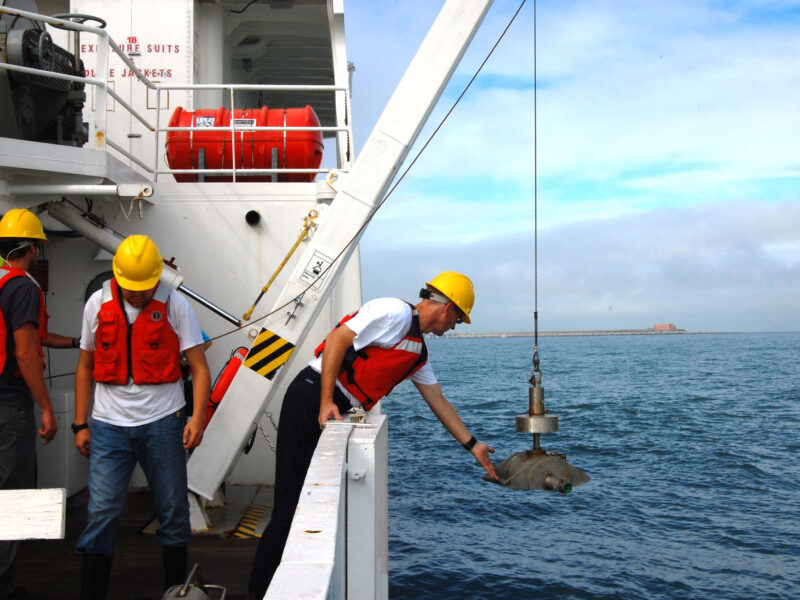Aquaculture (also known as mariculture) is one of the types of marine technology in which the breeding of aquatic species is done in captivity, such as fish and water plants. Aquaculture entails the production of both freshwater and saltwater fish in controlled circumstances.
A fish hatchery is a facility that releases young fish into the wild for recreational fishing or to save and better the number of a specific fish species. Carp, salmon, tilapia, and catfish are among the world’s most valuable aquaculture animals.
Here are the 12 latest technologies;
Underwater glider:
Underwater gliders are autonomous underwater robots with wings. This marine technology uses buoyancy control and direct thrust to travel through the water, just as a fish or an airplane would. Some of them may possess additional sensors such as sonar, GPS, and/or magnetometer to navigate inside the ocean and transmit information.

Remotely operated vehicle (ROV): The remotely operated vehicles or Remotely Operated Vehicles are unmanned watercraft. The underwater robots are either tethered to a boat, driven by an operator via manipulator’s arm while seeing through its camera eyes, or capable of being untethered and operating autonomously for hours on end without risk to the lives of humans. Some working models use water jets to move vertically and/or laterally, while others may decelerate by gliding.
Submarine:
A submarine is a vessel that can travel underwater independently. A submersible has less undersea capability than a submarine. It’s usually used to describe a huge, crewed ship, but it’s also occasionally used to refer to remotely operated vehicles and robots, as well as small or medium-sized boats like the midget submarine and wet sub. The shipping companies in Dubai also use this technology. “Underwater” has been used in many countries all over the world to describe anything relating to water or underwater since long before computers, tablets, and smartphones existed.
Read More: What are the factors affecting transportation?
Ocean thermal energy conversion:
Ocean thermal energy conversion (OTEC) is a proposed method of generating electrical power by extracting heat from the seas. The temperature difference between deep tropical waters and surface temperate or polar waters can be exploited to run steam turbines and produce electricity, potentially at very high efficiencies.

Osmotic power:
Osmotic power is an experimental renewable energy technology that derives energy from the difference in salt concentration between seawater and river water. This form of renewable energy has not yet been demonstrated to be feasible, because development efforts have focused on increasing efficiency by tweaking the design or changing the membranes used in prototype systems. However, recent advancements in membrane materials may lead to lower costs and increased efficiency.
PowerBuoy:
The PowerBuoy is a wave energy converter developed by Ocean Power Technologies (OPT) that uses the motion of ocean waves to generate electricity. The device floats tethered to the seabed in shallower water, where the waves are stronger which allows for a more efficient generation of power. The first two prototypes were built in Australia and deployed off the coast of Portugal.
Ocean thermal energy storage:
The ocean has a tremendous amount of thermal energy, which can be used to heat buildings or even generate electricity. To be practical, this must be done on a large scale and several locations have been proposed as candidates. Some of the most promising sites are in tropical locations where there is a large temperature difference between the surface and deep water.

Ocean Acoustic Waveguide:
The Ocean Acoustic Waveguide is a proposed method of long-distance underwater communications in which sound waves travel along the thermocline. This involves transmitting acoustic signals in the so-called deep sound channel. This channel exists in the ocean because sound travels further underwater when there is a larger temperature gradient, which is the difference between cool deep water and warm surface water.
Seawater Air Conditioning:
Seawater air conditioning (SWAC) is a process that uses seawater to provide air conditioning for coastal cities. It was initially proposed in 2008 by professors at the University of Virginia and is now being further developed as a possible solution to projected water shortages in coastal areas over the next few decades.
Ocean Fertilization:
Ocean fertilization involves adding nutrients to the upper ocean, which stimulates phytoplankton growth, increases marine food production, and removes carbon dioxide from the atmosphere. Several groups have been looking into the use of iron fertilization to combat climate change, though it is not clear that this will have a large impact.

Ocean acidification mitigation:
Ocean acidification occurs when carbon dioxide from the atmosphere dissolves in seawater. As the concentration of carbon dioxide increases in the atmosphere, more of it dissolves in the sea causing a reduction in pH which makes it more difficult for calcifying marine organisms to form their shells and skeletons. Research has shown that while this process will have significant effects on marine life, some species may be able to adapt or migrate to locations with less acidic water.
Ocean alkalinization:
The ocean has absorbed approximately one-third of all anthropogenic carbon dioxide emissions, which makes it an important factor in mitigating climate change. However, this also leads to the acidification of the surface waters and will have effects on marine organisms. Ocean alkalinization involves adding minerals such as lime to the ocean which would chemically neutralize some of this acid, creating new carbonate ions. This would have its greatest effects on phytoplankton and coral reefs, allowing them to grow more rapidly.
High-Frequency Radars:
High-Frequency Radars are a type of marine radar that uses microwaves with high frequencies. They work in shallow waters, unlike most other types of radar. These are used to monitor the movements of ships at sea and can be linked with Automatic Identification System (AIS) transponders for collision detection. It is a weatherproof device that can be used to detect ice, marine debris, and oil spills.
Ocean engineering is an emerging discipline that concerns itself with the design, construction, and operation of engineered systems in oceans. Ocean engineering applies traditional fields of engineering – such as mechanical, electrical, chemical, and civil – to several different problems at sea.






